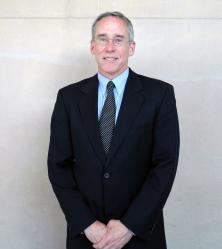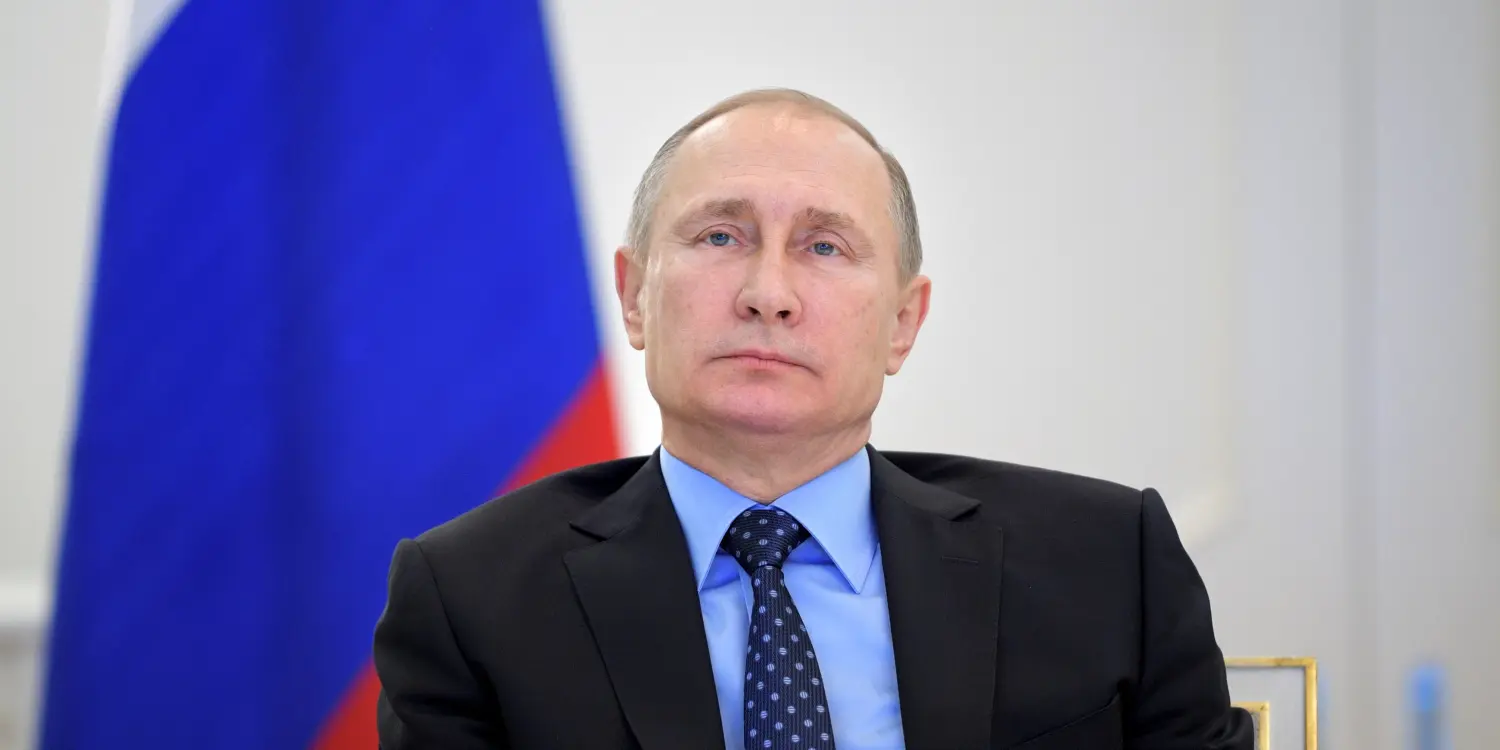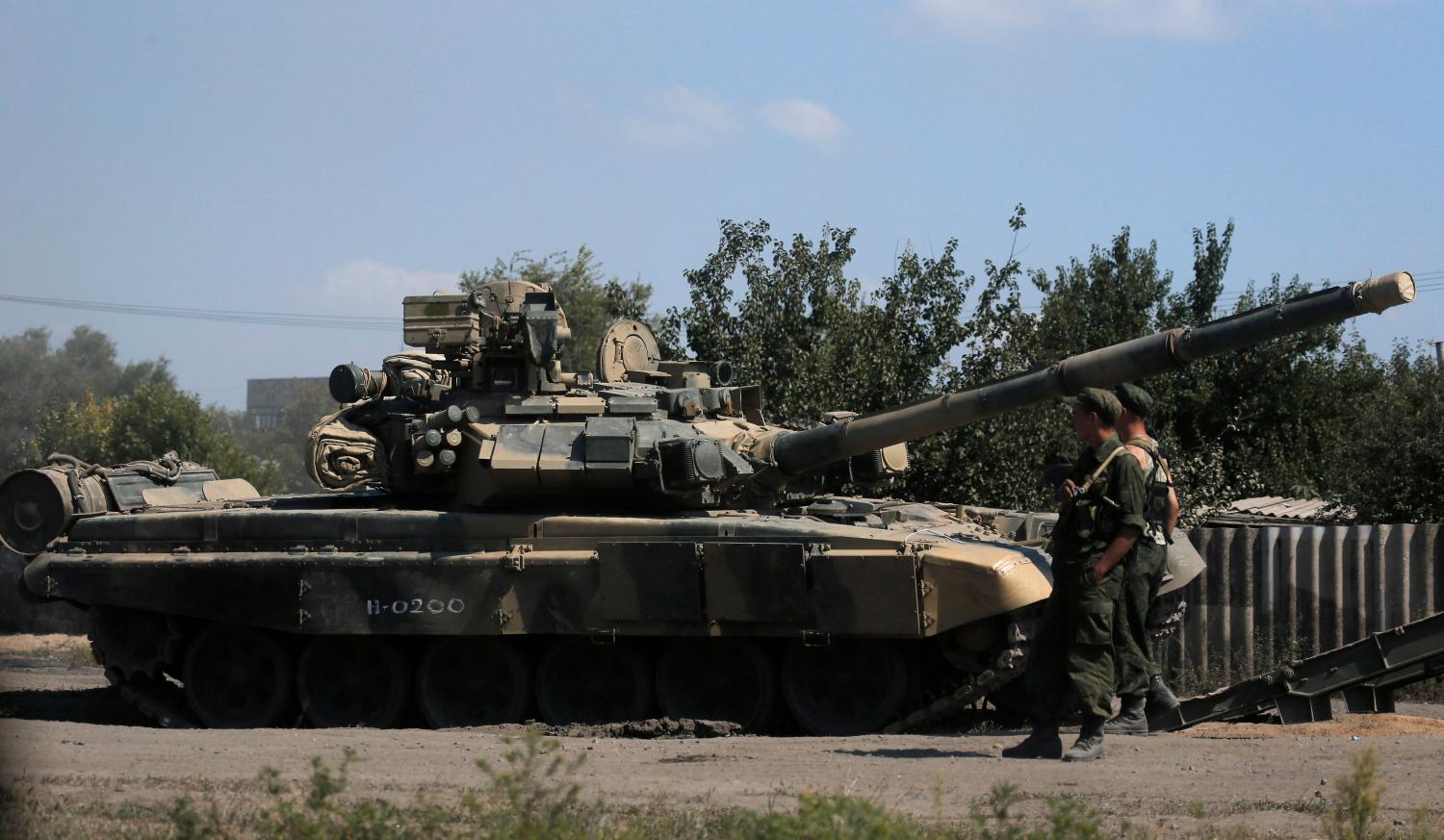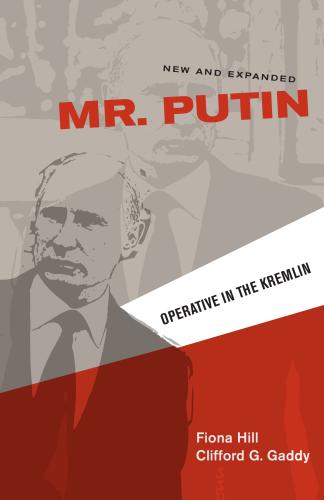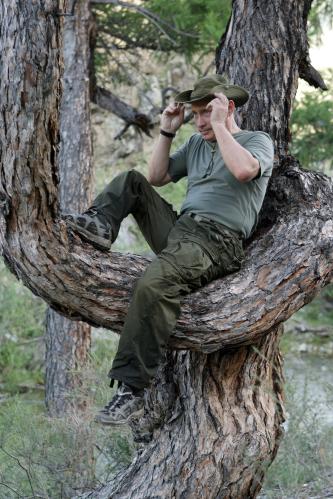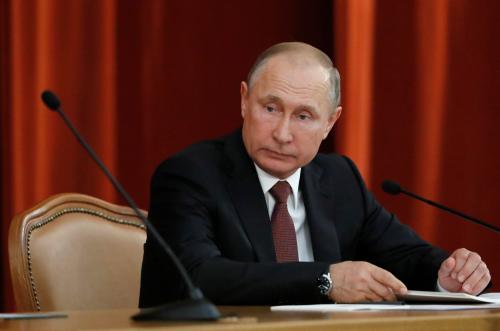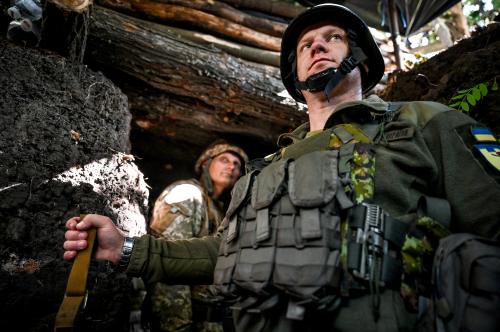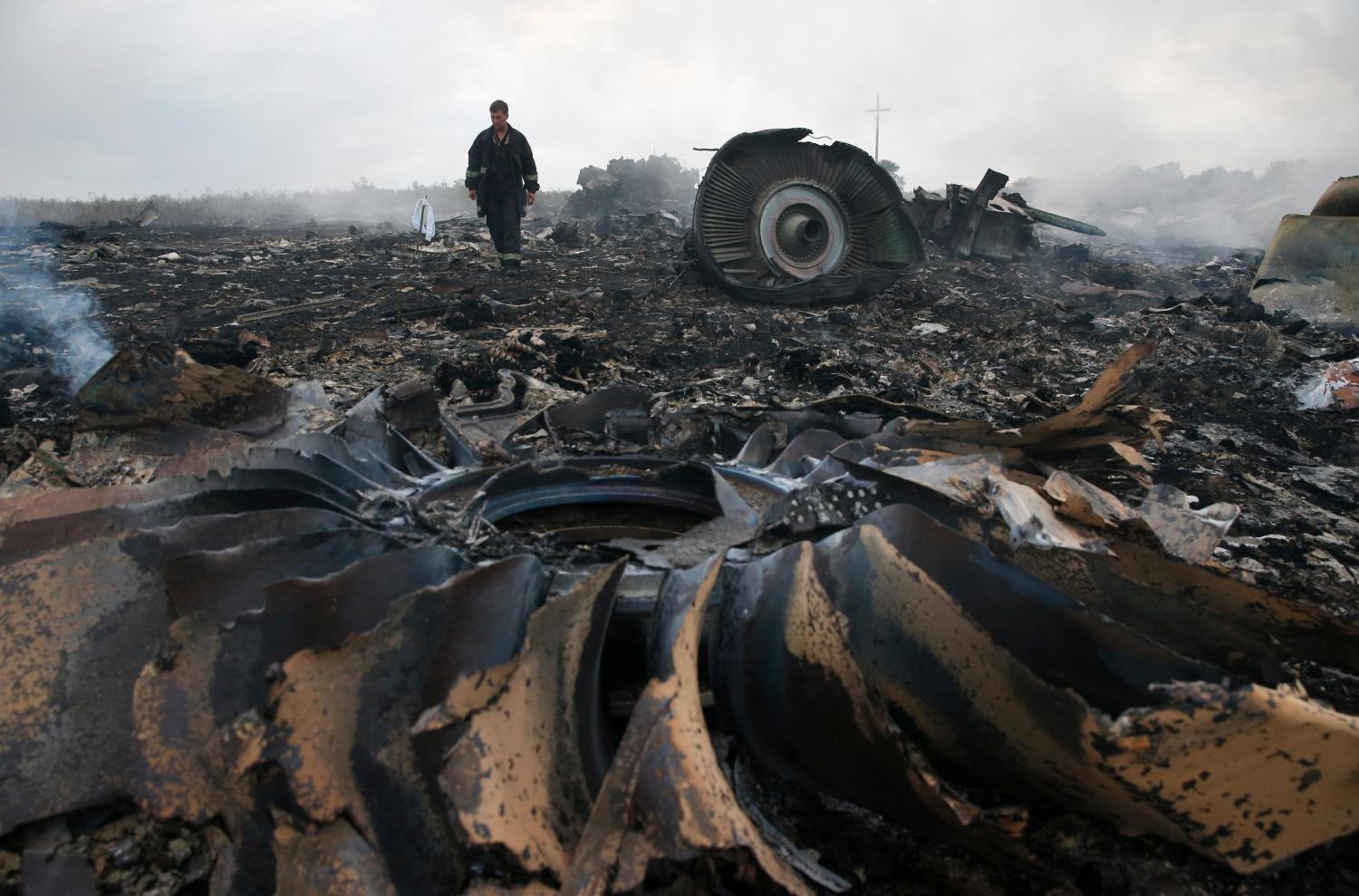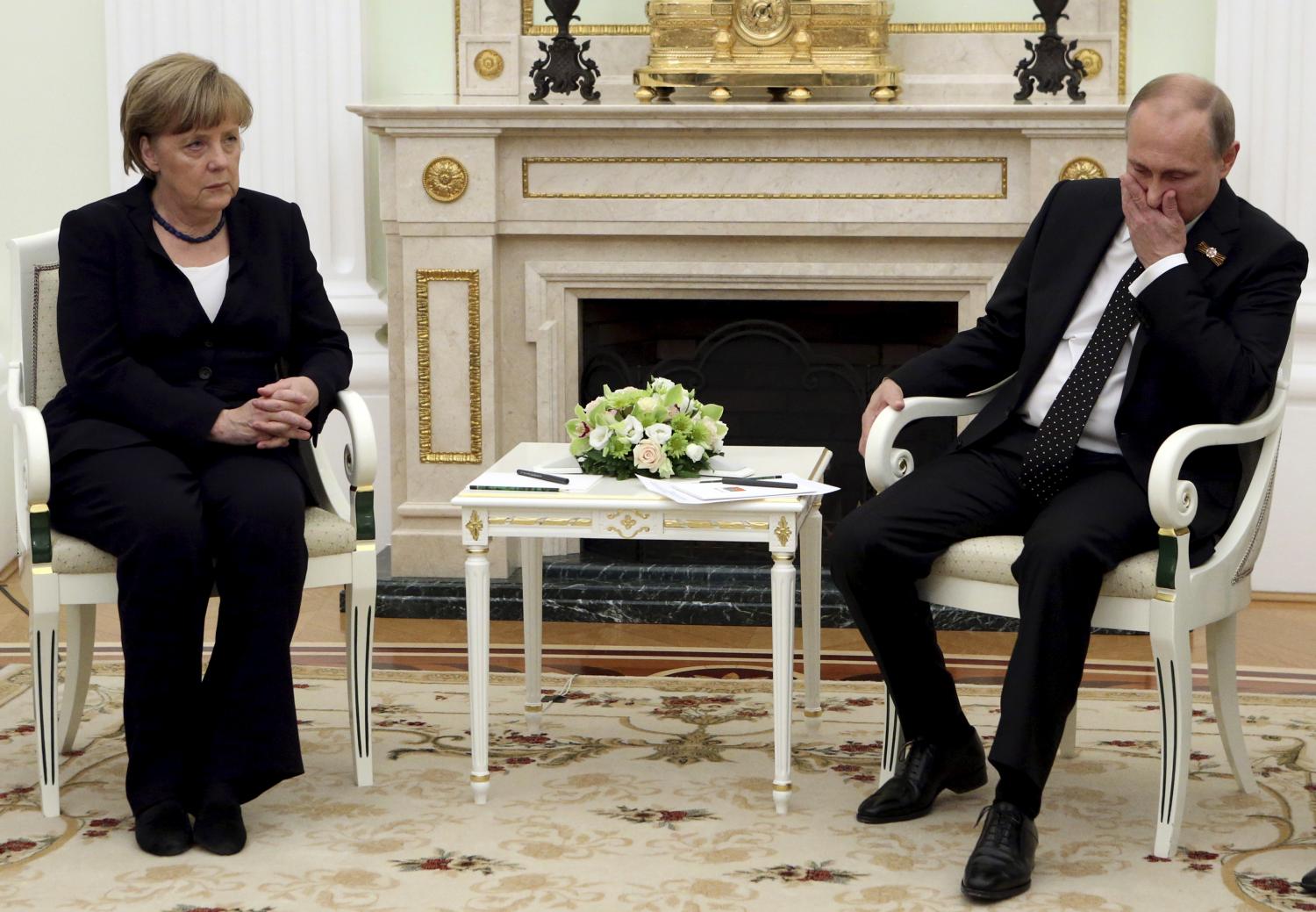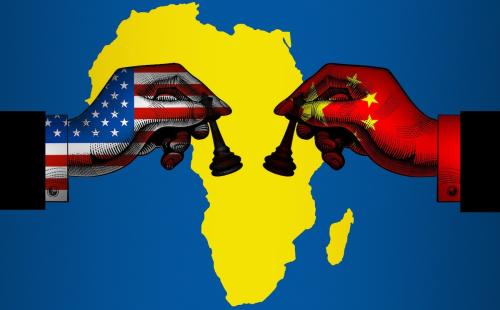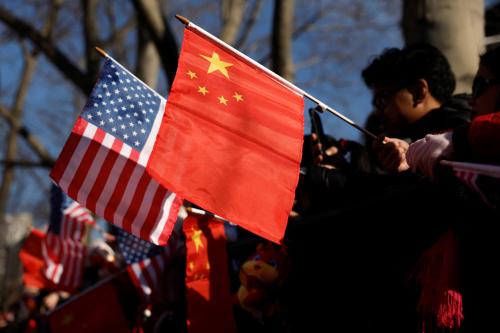This piece is adapted with permission from “Mr. Putin: Operative in the Kremlin” By Fiona Hill and Clifford G. Gaddy (Brookings Institution Press, 2015). In the book, they aimed to answer the question of who is Russian President Vladimir Putin and what motivates him. The authors noted that much of the commentary regarding Russia in the United States was built upon several, potentially very dangerous, misconceptions about Putin. With Russia and its involvement in U.S. domestic affairs currently at the forefront of national attention, their analysis has never been more relevant, or more vital. A lightly-adapted excerpt of the book’s coda is below. You can buy the book here.
In this book, we have tried to answer the question of who is Mr. Putin and what motivates him to do what he does. Here, in this coda, we put this understanding and these insights to the test. Based on what we’ve written, we consider what lessons we have learned and what advice we might offer on how to deal with him. The 2014 conflict between Russia and the West over Ukraine has convinced us that some observers of the crisis have several, potentially very dangerous, misconceptions about Putin. These fall into the category of underestimating him in a couple of important respects, and then overestimating him—or failing to understand his limitations—in others. First, many in the West underestimated Putin’s willingness to fight, for as long and as hard (and as dirty) as he needs to, to achieve his goals. Vladimir Putin will use all methods available, and he will be ruthless. Second, Western observers misread his skill as a strategist. Putin is not, as some have said, a mere tactician. He thinks strategically, and he has great advantages over Western leaders in his ability to translate that thinking into action. What we often fail to appreciate, however, is how dangerously little Putin understands about us—our motives, our mentality, and, also, our values. Only by trying to appreciate how Putin sees us can we see the logic in his actions—the logic he follows—and therefore get some idea of what he wants, where he might be headed, in Ukraine and elsewhere in Europe and Eurasia….
First, Vladimir Putin needs to be taken seriously. He will make good on every promise or threat—if Putin says he will do something, then he is prepared to do it; and he will find a way of doing it, using every method at his disposal. From Putin’s biographical materials… [he] and his Kremlin team wanted domestic and international audiences to conceive of him as a scrappy little street fighter (a little thug in Masha Gessen’s depiction in The Man Without a Face). All the stories laid out in these early materials and the subsequent embellishments were framed by the outbreak of the second war in Chechnya; but they were also intended to have a shelf-life for future events. Their purpose was to underscore that if Vladimir Putin gets into a fight, then he is prepared to fight to the end. He will keep on fighting, even if he gets beaten up (as a kid), or risks losing his position (as the official leader of Russia), or has to embark on a potential suicide mission (as his father did during World War II). Vladimir Putin may be an underdog—he’s small in stature, he seems weaker than his opponents, he was always in secondary, never high-profile, positions until the late 1990s—but he uses these and other attributes to his advantage.
Vladimir Putin is a fighter and he is a survivalist.
In short, Vladimir Putin is a fighter and he is a survivalist. He won’t give up, and he will fight dirty if that’s what it takes to win. He didn’t give up as a kid in the Leningrad courtyards. He didn’t give up in Chechnya. He won’t give up in Ukraine or elsewhere in Russia’s neighborhood. Vladimir Putin’s rules for street fighting are essentially the same for his principles in domestic and foreign politics. Establish credibility and don’t back down until the advantage is yours and you’ve made your point. Once your opponent has capitulated and you have established your turf and terms, then you can patch things up and move on—until the next showdown comes along. Whether the stories Putin and his team tell about his childhood fights are all true or not, Putin’s martial arts training lends them some veracity. It also brings in another dimension. Putin began with judo and the somewhat rougher Russian variant called sambo at an early age. Judo gave Putin a more disciplined and ritualized approach to fighting. It helped him overcome his own weaknesses in terms of his size and strength relative to others. Judo moved the street kid from anything goes scraps into formalized matches. It gave him insight and techniques to figure out ways of pushing bigger, stronger opponents to the mat while protecting himself.
In the domestic and foreign policy arenas, Putin constantly sizes up his opponents and probes for physical and psychological weaknesses. Putin’s adaptation of Nixon’s “Madman Theory” approach helps flush these weaknesses out—it helps gauge reactions: They think I’m dangerous, and unpredictable, how do they respond to this? Have I got them unbalanced and on the back foot as a result? Then Putin tests his opponents to see if they mean what they say—will they also be prepared to fight, and fight to the end? If they are not, then he will exploit their empty threats to show them up, intimidate, deter, and defeat them. If they are prepared to fight, and he is outweighed or outgunned by his adversaries, then he will look for unconventional moves that get around their defenses so that he can outmaneuver them. In judo you can win on points over the course of a series of matches even if you are far smaller than your opponent and lose some of the individual rounds.
Much of this is borne out by events since Putin became president. As we have laid out in the book, all of Putin’s tactics at home and abroad are geared toward gaining advantage against his opponents—be they oligarchs and opposition figures in Russia, or Western leaders and international organizations. To maximize the tactical advantage, Putin and the Kremlin work very hard at making him as inscrutable and unpredictable as possible. Access to Putin is strictly limited. His image is carefully branded and rebranded. Putin’s appearances and public pronouncements are highly orchestrated and well-prepared. They are timed for maximum effect so that his audiences will hang on his every word—looking for any indication of what he might think, or what he might do next. The Kremlin maintains an almost complete unity of silence and message. When messages seem to be transmitted without approval they are accompanied by equal measure of dis/mis-information. All of this deliberately complicates the task of the political opponent (as well as the outside analyst or biographer). Vladimir Putin is, and is supposed to be, unknowable to the outsider. The goal is to keep everyone confused and off balance.
The notion that Putin is an opportunist, at best an improviser, but not a strategist, is a dangerous misread.
These points can be traced through some of the events we refer to in the book. In Georgia in 2008, for example, Putin called the West’s bluff about standing by its friends—which is what U.S. Secretary of State Condoleeza Rice told Georgian President Mikheil Saakashvili that the West would do during a visit to Tbilisi shortly before the August war. From Putin’s perspective, given all the emphasis the Bush Administration put on Georgia in its foreign policy, he thought this meant that the United States was prepared to fight militarily, not just rhetorically, for Georgia. Moscow was steeled for a possible fight with NATO. Many Russian officials in private meetings with the authors related the tension in Moscow security circles in August 2008. They talked of the fear in the Russian military that the U.S. and NATO would strike back, and that they might then have to face a NATO force in some form, not just the Georgian army. When the United States and NATO did not come to Georgia’s aid militarily, and the European Union, with then French President Nicholas Sarkozy out in front, rushed to broker a ceasefire, there was a sigh of relief in Moscow. NATO was still a formidable conventional fighting force, of course, but it did not have the political will to fight for partners outside the alliance, and the frame of Article 5—even if (as in the case of Georgia) those partners were fighting alongside NATO forces in coalitions in Afghanistan and Iraq. Putin understood that the United States’ security priorities were focused elsewhere. The West wanted to contain Russia on the cheap in Europe and Eurasia. The United States, NATO, and the EU would do everything they could to head off another major military confrontation, a “World War III,” in Europe.
However, from Putin’s perspective, there might come a point in the future where those priorities would change for the U.S. and NATO. If so, he would have to think in terms of such a worst-case scenario. We are convinced that this is exactly how Putin thinks, because, contrary to the prevailing external assessment, Putin is a strategic planner. The notion that Putin is an opportunist, at best an improviser, but not a strategist, is a dangerous misread. Putin thinks, plans, and acts strategically. But, as we have stressed in the book, for Putin, strategic planning is contingency planning. There is no step-by-step blueprint. There are strategic objectives, and there are many ways to achieve those objectives. Exactly what his next step towards the objective will be depends on the circumstances. It depends on how his adversary reacts.

Putin has the same priorities today that he laid out at the beginning of his presidency in December 1999. His larger strategic goal is ensuring the defense of Russia’s interests—which are tightly fused with, and now largely inseparable from, his own and his system’s interests. As Russia’s president, Putin is… set on restoring, consolidating, and defending Russia’s position. As the “CEO of Russia, Inc.”, Putin’s task is to protect the core assets of the economic system that he controls and which is managed by his inner circle. In both guises, Putin has to figure out how to plan for the present and future under conditions of economic and political uncertainty. Putin knows unexpected events can and will blow things off course in domestic and foreign policy. The key to dealing with the unexpected is to anticipate that there will always be setbacks. This means he focuses on contingency and adaptive planning to deal with them. He needs back-up plans and resources ready whenever they come along. Having back-up plans means learning from past mistakes as well as successes. It means reducing risk and vulnerability for the future. Putin has consistently shown that he can learn from his own policy or tactical mistakes at home and abroad. In his pronouncements and actions, Putin has emphasized the importance of operational flexibility and of maximizing options so he can adapt to changes in Russia’s internal and external environment as he goes along.
Another aspect of Putin’s strategic approach is to simplify and streamline his leadership at home and his interactions abroad. By creating a system in which he only has to deal with a small number of actors, Putin frees himself from having to deal with details and messy dynamics. He identifies and recruits people who can deliver results and holds onto them, both at home and abroad. Inside “Russia Inc.”, Putin creates incentives, rewards and rules to keep his core team together. He does not micromanage; he monitors. He checks-in periodically to make sure everyone in his core team and at lower operational levels knows what they’re doing; and he steps in only if things go wrong and he has to put things back on track. He insists on cohesion and consensus—keeping his challengers as much as possible in his “big tent.” He shows them respect, gives their ideas a regular hearing, and gives them a stake in the system. But anyone who breaks the rules he has laid down in domestic and foreign policy is punished severely—from Mikhail Khodorkovsky to Mikheil Saakashvili.
By creating a system in which he only has to deal with a small number of actors, Putin frees himself from having to deal with details and messy dynamics.
Again, this plays out in foreign policy events. As we discuss in the book, Putin had clearly decided sometime before the Munich Security Conference in 2007 that he would eventually have to confront the United States, on what he perceived to be its destabilizing behavior, with something more forceful than heightened rhetoric. In the case of Georgia, Putin knew that Mikheil Saakashvili was going to keep on pushing to reassert Georgia’s control over the secessionist republics of Abkhazia and South Ossetia, including trying to retake them by force if he felt he had to or could. Saakashvili never hid this intention. He often spoke of it to interlocutors, including to the authors on two occasions several years apart. Saakashvili also made it clear that he would keep pressing for NATO membership in some form. So Putin had contingencies prepared, including the armed forces’ annual summer exercises in the North Caucasus military district. Sure enough, Saakashvili tripped the wire in 2008. After the Georgia war, Putin and his team looked back over the conflict and examined what had gone wrong in detail. They looked at Russia’s large-scale military operations first in Chechnya and then in Georgia and at the West’s responses. They decided that they needed to do something different when the next time came along.
The next time was Ukraine. Putin first took the 2011-2012 protests as a signal that the West had opened another front of attack and he would need to take immediate preparatory action. Putin set [Armed Forces Chief of Staff] Gerasimov and [Defense Minister] Shoigu to work at the end of 2012 to mobilize Russia for fighting the new twenty-first century warfare with the West. Putin’s second signal was the European association agreements in 2013, combined with the EU’s decision to initiate its Third Energy Package and the financial crisis in Cyprus in March 2013. All this revealed how negative attitudes toward Russia had become in Brussels and Berlin. Initially in Ukraine, Putin thought he had the situation under control with the venal and vulnerable Victor Yanukovych in place. But he had bet on the wrong horse. Yanukovych could be blackmailed but he couldn’t keep control of Ukraine. Once it became clear that Yanukovych had “no political future”—which may have been in December 2013 when the protests in Kyiv stepped up, or not until February 2014 when things really got out of hand—then Putin had to make sure his backup plans were in place. Annexing Crimea and setting the rest of Ukraine on fire were contingency operations. They were prepared in advance, ready to be used if needed—but only if needed.
Unexpected future events would also have to be dealt with. The downing of Malaysian Airlines Flight MH17 over eastern Ukraine in July 2014 was one of those: it was a particularly tragic example of events blowing plans off course. Until the Malaysian Airlines disaster, the European Union had been lukewarm on imposing sanctions on Russia in response to the annexation of Crimea. MH17 was a game changer for Europe. Most of the casualties were European, citizens of one of Russia’s closest trading partners, the Netherlands (and as it turned out as a result of all the bad press, the sometime home of one of Putin’s daughters). However, this event was not a game changer for Putin. He would stick to his overall strategy. But he would adapt his tactics to the new circumstances, the new “input.” Putin had already anticipated that there would be sanctions—they were a favored punitive foreign policy tool of the United States, even if the U.S. had been reluctant to apply them in Georgia in 2008. Putin had started to prepare for this inevitability in advance. He had tried to boost Russia’s overall economic leverage with the West and he had pushed to de-offshore and diversify trade once he was back in the presidency. Now Putin would have to find ways of dealing with an intensified level of sanctions—including through non-economic means. In the case of MH17, Putin hit back with Russia’s own (asymmetric) sanctions accompanied by a barrage of propaganda and misinformation to confuse the issue, sow doubt, deflect attention away from who might actually have shot down the plane and why. And he stepped up the military aspects of the conflict in eastern Ukraine. He did not back down in any meaningful way….
Putin has only a handful of contacts with U.S. and European insiders and thus a very incomplete grasp of what motivates or drives Western leaders. Finding himself too far outside their political perspectives and interactions, Putin falls back on his (and Russia’s) age-old threat perceptions. He looks for, and finds, plots and conspiracies. The plots he finds are consistent with his logic. They make sense in terms of his frame of reference—as seen through his filters of the Cold War, the KGB, his time in Dresden, and the prevailing political views of conservative and patriotic Russia circles. This does not mean that the plots exist or that his views are correct. Putin’s “too-far-outside,” other-world, perspective is a source of weakness in this respect, not strength. Vladimir Putin has spent a great deal of time in his professional life bending the truth, manipulating facts, and playing with fictions. He is also, we conclude, not always able to distinguish one from the other, his tools for doing so are often inadequate. This is a source of danger in Russia’s relations with the West.
The United States and Europe encourage political and economic change as a matter of course in their foreign policies. The essence of Western political systems extends to promoting democracy and liberal markets abroad. Western leaders and their populations see this as benign. From Vladimir Putin’s perspective, it is not all at benign. Western style-democracy and open markets are a clear threat to a Russian political system that thrives as a closed one-boy network and an economic protection racket. The United States and the EU have not set out, as Putin assumes, to overturn his regime in a color revolution. But, many Western politicians and opinion leaders have made it very clear that they would like to see the political system in Russia changed and another leader with a more “Western outlook” take Putin’s place. Given the frequent references in the Western press to the prospect of a Russia without Putin, and Putin’s own mindset, it is unlikely that he will be convinced that the U.S. and Europe are not “out to get rid of him.” The escalatory sequence of events in Ukraine in 2014—with successive rounds of Western sanctions, NATO stepping up its defenses, and calls for military assistance to Ukraine have further darkened Putin’s views about the West and deepened his convictions about malign intent.
As many scholars of international affairs and psychologists have pointed out, perceptions and misperceptions are as potent as actual facts. Once an erroneous set of views takes hold, it is hard to refute and change them. In the case of Putin, his mindset is deeply rooted. The West will find it hard to change his views. Putin has no reliable interlocutors in the West from his perspective, only a handful of intermediaries. And he simply does not trust anyone. Any effort to persuade him that he has misread the situation in some definitive, black-and-white, way will likely be seen as a ploy. Restoring a degree of trust is not impossible, but it will be extremely difficult. In the meantime, the West will have to deal with the reality of Putin’s views: the fact that he does think differently from his U.S. and European counterparts. He does see the West as a threat to him and his system.
[H]is mindset is deeply rooted. The West will find it hard to change his views.
So what about the conflict in Ukraine that Putin sparked in 2014? What does he want; and what might he do next? As he laid out in his August 2014 speech in Crimea, Putin seeks a “New Yalta” with the West in political and security terms. As he defines Moscow’s sphere of influence in this new arrangement, that sphere extends to all the space in Europe and Eurasia that once fell within the boundaries of the Russian Empire and the USSR Within these vast contours, Putin and Russia have interests that need to be taken into account, interests that override those of all others. For Putin, Russia is the only sovereign state in this neighborhood. None of the other states, in his view, have truly independent standing—they all have contingent sovereignty. The only question for Putin is which of the real sovereign powers (Russia or the United States) prevails in deciding where the borders of the New Yalta finally end up after 2014.
Unlike the old Yalta of the post-World War II Soviet period, Putin’s New Yalta does not extend to economics. Putin wants preferential, even protectionist, provisions for the Russian economy, but he does not espouse the creation of rigid opposing economic blocs or autarky. That simply will not work in today’s global economy. Putin does not want to put Russia on a path to international isolation. He wants there to be, as he says, economic and geopolitical “demand” for Russia. He does not want Russia to end up being a pariah state like North Korea. Putin has made sure Russia has foreign policy and trade options to avoid this fate. He has diversified foreign policy and forged new multilateral and bilateral relations outside the Euro-Atlantic system. At the same time, Putin does not want to completely jettison Russia’s ties with the United States and Europe. This is neither practical nor possible, nor even desirable, given the past two decades of interaction and integration, and Putin still holds out hope for making good on his Germany wager—by persuading Germans that all is not lost and Berlin can return to the close economic and political relations with Moscow that prevailed until the crisis in Ukraine.
In short, in spite of his decision to go to war in Georgia in 2008 and again in Ukraine in 2014, Putin still wants to do business with the West. In political terms, this means collaboration when security interests actually do overlap. He and Russia can work with the United States and the EU on dealing with issues like Iran and curbing its nuclear weapons systems, or dismantling Syrian chemical weapons, or containing the activities of militant Islamist extremists across the Middle East and in Afghanistan. In his view there is no need to cut off cooperation on issues where there is a mutual strategic interest. Indeed, it is only by having a place at the international diplomatic table on these and other issues that Putin can protect Russia’s position. Putin will not cut off diplomatic ties if this will hurt Russia. But most of all Putin is concerned about the economy. He literally wants to do business—trade and investment—with the West. In this case, he is an exaggerated version of his former self as deputy mayor of St. Petersburg in charge of external relations…. He is still presiding over Russian economic relations, wheeling and dealing. Putin eventually wants to put the war in Ukraine aside, separate it off—war is war, but business is business. Western politicians want to fight with me, but their businessmen want to keep working with Russia.
In the meantime, until a “new Yalta” is thrashed out, Russia and the West will remain at war. They will be fighting a new war that is fought everywhere with non-military as well as military means. Ultimately, in pursuing his goals…, Putin remains a pragmatist. In figuring out how to prevail in this war, Putin knows that Russia does not have the economic or military resources for the old Soviet (and Russian) mass-army, total mobilization approach to defending its interests. Given the contemporary balance of forces, Russia will always lose in such a conflict. The United States, NATO members, and other de facto U.S. allies have a collective GDP more than ten times that of Russia’s as well as more conventional arms. Putin needs to avoid a good old-fashioned twentieth century war (even a small one) and accomplish his goals without resorting to total mobilization. Twenty-first century wars involve targeted non-military efforts. They are the least disruptive to the normal functioning of the Russian economy even though they can also be very damaging.
In Ukraine and elsewhere in Russia’s neighborhood, Putin wants the West to sue for peace without jumping into the military war phase. The 2014 war is essentially a big (war) game of “chicken.” Based on the West’s past performance in Georgia, Putin anticipated that the West would blink first in Ukraine, baulking at the high costs of the confrontation, which he laid out very clearly with his offensive defense. Ukraine would burn in the east and the flames would fan out further and further. On the very occasion of their anniversaries, the conflagrations of the twentieth century would be reignited in the same territories in the twenty first. The Cold War decades would end with another hot war, not a cold peace.
This game of chicken will be a long one…there is no definitive endgame.
This game of chicken will be a long one. Putin’s goal is security for Russia and his system. The means to achieve that goal is deterrence. As has often been pointed out, the Russian word for security, bezopasnost’, means literally “absence of danger or threat.” As a result, there is no definitive endgame. He will keep on playing as long as he perceives the threat to last. Even if he does secure a “new Yalta” deal in some form, he has no intention of abandoning his new warfare, because it is his way of deterring threats. In Vladimir Putin and his team’s conception of the new twenty-first century warfare, there are no real declarations of war, and thus no real peace settlements—only partial ceasefires. Putin will keep all options open. He will continue to enhance Russia’s capabilities. He will calibrate and recalibrate his actions based on the responses and reactions of his opponents. Putin’s will make sure his threats of Russian military action remain credible. Vladimir Putin is not Boris Yeltsin, and Putin’s Russia has not resembled Yeltsin’s Russia or been run like Yeltsin’s Russia for a very long time.
In the 1990s when Yeltsin did not take strong action on issues inimical to Russia’s interests, U.S. and European leaders routinely assumed that this was because Yeltsin had made a strategic decision not to do so. When Yeltsin objected to NATO expansion or NATO’s intervention in Yugoslavia, his verbal complaints were considered perfunctory. Yeltsin, Western leaders concluded, had put his priority on good relations with the West no matter what. But Yeltsin and Russia were heavily indebted to the West. The economy was in ruins, the political system was a shambles, the security structures were gutted. In many respects, Yeltsin could not act in the 1990s because Russia was constrained. If Yeltsin made a threat it was empty. He did not have the resources, the capacity to back it up.
Vladimir Putin has no such constraints. Sanctions hurt, but they do not deter him as they deterred Yeltsin. Putin has the capacity to act, and he is willing to escalate to deter the West instead. Putin has even put the nuclear option on the table to “scare the hell out of” the West.… Putin knows he has to make the West think he will use nuclear weapons if the war moves to the military phase, not just that he might use them. This is the ultimate deterrent. Putin is not hell-bent on destroying Russia or his presidency and his system. He will have a contingency for deploying nuclear weapons if he feels he needs to, but… Putin wants the Russian state to survive with him at its head, even as he wants to push the United States and Europe away from Russia and out of its neighborhood.
As far as what Vladimir Putin might do next, it seems rather clear: he will keep Ukraine boiling, and he will prepare for contingency operations elsewhere in the neighborhood. Putin will rely on asymmetry and the element of tactical surprise, whenever and wherever he strikes next, for maximum effect. Beyond Ukraine, all of Eastern Europe, the former Soviet bloc, has vulnerabilities…. Baltic states like Estonia have shaky border agreements with Russia; they also have Russian speakers without citizenship. Both can be used to good effect. Old Cold War methods can be deployed across the region that fall short of the threshold of triggering an armed response from NATO. Ships can be interdicted near Russian waters, air defenses can be penetrated, weapons systems and army maneuvers can move closer and closer to vulnerable land and sea borders. If there were illegals still operating in Germany, the chances are there are plenty of other Russian operatives across the old Soviet bloc, collecting compromising and operational information, and waiting to subvert governments, discredit individual leaders who challenge Russia, and block any actions that run counter to Russian interests. Across the rest of Europe, foreign businessmen, journalists, regular citizens, activists and operatives can all be detained on various charges of violating Russian borders or laws. These methods, and countless more, are all tools that Putin can apply if NATO or the EU contemplate another round of expansion and keep on pressing forward in Ukraine.
Putin’s operational aim will continue to be to find the weaknesses, to goad, and intimidate, and to make sure everyone knows he will make good on his threats. The onus will now be on the West to shore up its own home defenses, reduce the economic and political vulnerabilities, and create its own contingency plans if it wants to counter Putin’s new twenty-first century warfare.
The Brookings Institution is committed to quality, independence, and impact.
We are supported by a diverse array of funders. In line with our values and policies, each Brookings publication represents the sole views of its author(s).

